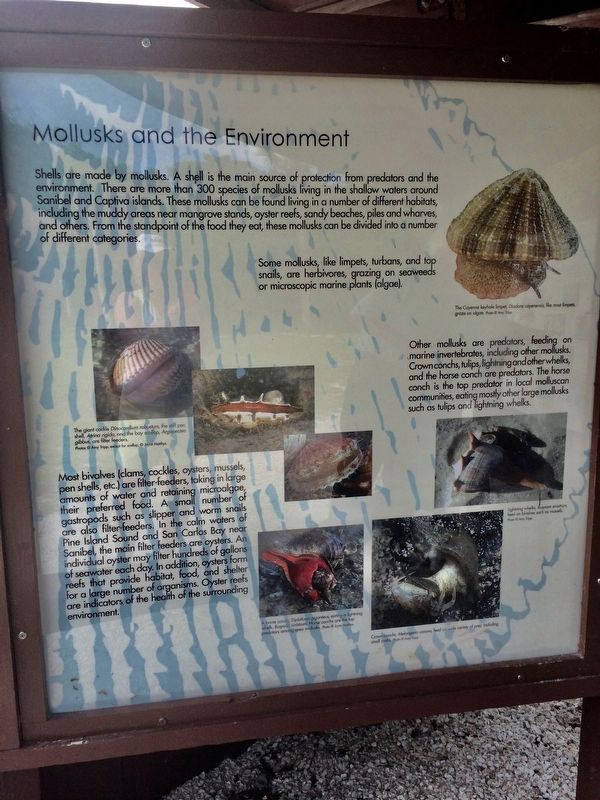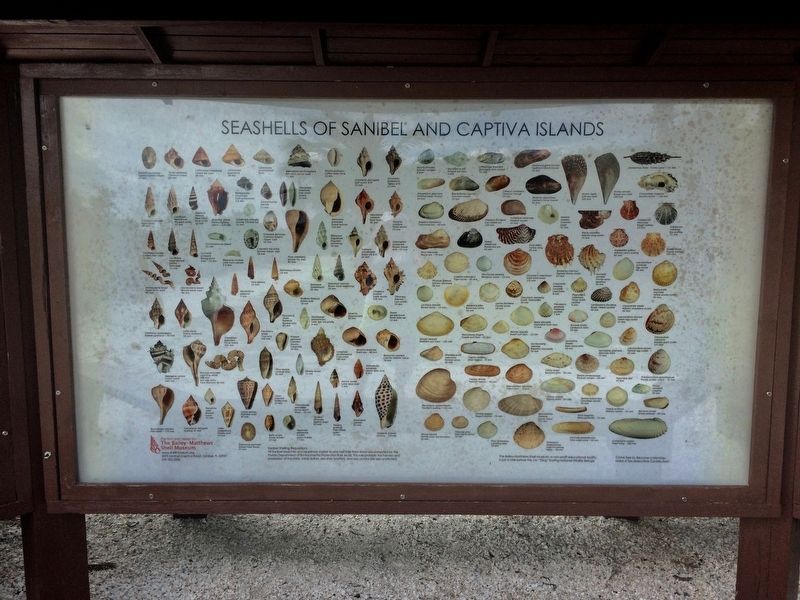Sanibel Island in Lee County, Florida — The American South (South Atlantic)
Mollusks and the Environment
Some mollusks, like limpets, turbans, and top snails, are herbivores, grazing on seaweeds r microscopic marine plants (algae).
Other mollusks are predators, feeding on marine invertebrates, including other mollusks. Crown conchs tulips, lightning and other whelks, and the horse conch are predators. The horse conch is the top predator in local molluscan communities, eating mostly other large molluscan such as tulips and lightning whelks.
Most bivalves (clams, cockles, oysters, mussels, pen shells, etc.) are filter-feeders, taking in large amounts of water and retaining micro-algae, their preferred food. A small number of gastropods, such as slipper and worm snails are also filter-feeders. In the calm waters of Pine Island Sound and San Carlos Bay near Sanibel, the main filter-feeders are oysters. An individual oyster may filter hundreds of gallons of seawater each day. In addition, oysters form reefs that provide habitat, food and shelter for larger number of organisms. Oyster reefs are indicators of the health of the surrounding environment.
• The Cayenne keyhole limpet, Diodora cayenensis, like most limpets graze on algae.
Photo by Amy Tripp
• The giant cockle Dinocardium robustum, the stiff pen shell, Atrina rigid and the bay scallop, Argopecten gibbus, are filter-feeders.
Photo by Amy Tripp except for scallops by Joyce Matthys
• The horse conch, Triplofusus giganteus, eating a lighting whelk, Busycon sinistrum. Horse conchs are the top predators among area mollusks.
Photo by Joyce Matthys
• Crown conchs, Melongena corona, feed on wide variety of prey, including small crabs.
Photo by Amy Tripp
• Lightning whelks, Busycon sinistrum, feed on bivalves such mussels.
Photo by Amy Tripp
Topics. This historical marker is listed in these topic lists: Animals • Environment.
Location. 26° 27.161′ N, 82° 0.878′ W. Marker is on Sanibel Island, Florida, in Lee County. Marker is on Periwinkle Way. Marker is located Sanibel Lighthouse Beach Park. Touch for map. Marker is at or near this postal address: 110/152 Perwinkle Way, Sanibel FL 33957, United States of America. Touch for directions.
Other nearby markers. At least 8 other markers are within 6 miles of this marker, measured as the crow flies. Sea Turtles on Sanibel (here, next to this marker); Sanibel & Everglades Restoration (here, next to this marker); The Beach is a wild place (a few steps from this marker); Molluscan Reproduction and Egg Case (a few steps from this marker); Sanibel Lighthouse (within shouting distance of this marker); Nature's Landlord (within shouting distance of this marker); Plants and Progress (approx. 5.4 miles away); People and Plants (approx. 5.4 miles away). Touch for a list and map of all markers in Sanibel Island.
Also see . . .
1. Cayenne keyhole limpet. The Cayenne keyhole limpet, scientific name Diodora cayenensis, is a species of small to medium-sized sea snail or limpet, a western Atlantic marine prosobranch gastropod mollusk in the family Fissurellidae, the keyhole limpets. This species is named after Cayenne, the capital of French Guiana. The spelling using one "n" is original and is therefore retained. (Submitted on July 29, 2017, by Sandra Hughes Tidwell of Killen, Alabama, USA.)
2. Dinocardium robustum. Dinocardium robustum, common name the Atlantic giant cockle, is a species of large saltwater clam, a marine bivalve mollusk in the family Cardiidae, the cockles. (Submitted on July 29, 2017, by Sandra Hughes Tidwell of Killen, Alabama, USA.)
3. Triplofusus giganteus. Triplofusus giganteus, previously known as Pleuroploca gigantea, common name the Florida horse conch, is a species of extremely large predatory subtropical and tropical sea snail, a marine gastropod mollusc in the family Fasciolariidae, the spindle snails, tulip snails and their allies. Although known as a horse conch, this is not a true conch, as it is not in the family Strombidae. This species is the largest gastropod in the American waters,[3] and one of the largest univalves in the world. (Submitted on July 29, 2017, by Sandra Hughes Tidwell of Killen, Alabama, USA.)
4. Melongena corona. The shell of this species is extremely variable in terms of the degree of spiny ornamentation. Some shells are much smoother than others. These snails cane as large as about 5 in (12 cm) long, and are mostly dark brown with irregular bands of white or cream. There are small spines on the largest whorl of the smoother forms,; the most spiny forms have several rows of spines. The aperture of the shell can be closed at will with an operculum. This snail is a predator; it eats other mollusks, including scallops.[2] (Submitted on July 29, 2017, by Sandra Hughes Tidwell of Killen, Alabama, USA.)
5. Busycon. Busycon is a genus of very large edible sea snails, marine gastropod mollusks in the family Busyconidae. These snails are commonly known in the United States as whelks or Busycon whelks. Less commonly they are loosely, and somewhat misleadingly, called "conchs". Busycon comes from the Greek bousykon meaning large fig, from bous meaning cow and sykon meaning fig. (Submitted on July 29, 2017, by Sandra Hughes Tidwell of Killen, Alabama, USA.)
Credits. This page was last revised on August 30, 2017. It was originally submitted on July 29, 2017, by Sandra Hughes Tidwell of Killen, Alabama, USA. This page has been viewed 223 times since then and 8 times this year. Photos: 1, 2. submitted on July 29, 2017, by Sandra Hughes Tidwell of Killen, Alabama, USA. • Bill Pfingsten was the editor who published this page.

